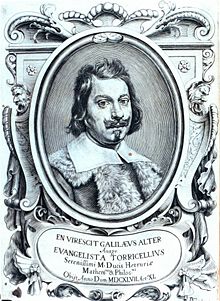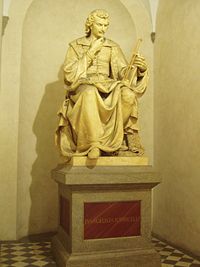Evangelista Torricelli
Evangelista Torricelli (October 15, 1608 – October 25, 1647) was an Italian physicist and mathematician, best known for his invention of the barometer.
Biography
Torricelli was born in Faenza Papal States. He was left fatherless at an early age and educated under the care of his uncle, a Camaldolese monk, who first entered young Torricelli in a Jesuit College in 1624 to study mathematics and philosophy until 1626, when he sent Toricelli to Rome in 1627 to study science under the Benedictine Benedetto Castelli, professor of mathematics at the Collegio della Sapienza in Pisa.
In 1632, shortly after the publication of Galileo's Dialogue concerning the Two Chief World Systems, Torricelli wrote to Galileo of reading it "with the delight [...] of one who, having already practised all of geometry most diligently [...] and having studied Ptolemy and seen almost everything of Tycho [Brahe], Kepler and Longomontanus, finally, forced by the many congruences, came to adhere to Copernicus, and was a Galileian in profession and sect". (The Vatican condemned Galileo in June 1633, and this was the only known occasion on which Torricelli openly declared himself to hold the Copernican view.)
Aside from several letters, little is known of Torricelli's activities in the years between 1632 and 1641, when Castelli sent Torricelli's monograph of the path of projectiles to Galileo, then a prisoner in his villa at Arcetri. Although Galileo promptly invited Torricelli to visit, he did not accept until just three months before Galileo's death. During his stay, however, he wrote out Galileo's Discourse of the Fifth day. After Galileo's death on January 8, 1642, Grand Duke Ferdinando II de' Medici asked him to succeed Galileo as the grand-ducal mathematician and professor of mathematics in the University of Pisa. In this role he solved some of the great mathematical problems of the day, such as finding a cycloid's area and center of gravity. He also designed and built a number of telescopes and simple microscopes; several large lenses, engraved with his name, are still preserved at Florence. In 1644, he famously wrote in a letter: "We live submerged at the bottom of an ocean of air."
Torricelli died in Florence a few days after having contracted typhoid fever, and was buried in San Lorenzo. The asteroid (7437) Torricelli was named in his honor.
Contributions to physics
Torricelli's chief invention was the barometer, which arose from solving an important practical problem. Pumpmakers of the Grand Duke of Tuscany attempted to raise water to a height of 12 meters or more, but found that 10 meters was the limit to which it would rise in the suction pump. Torricelli thought to employ mercury, fourteen times as heavy as water. In 1643 he created a tube c. 1 meters long, sealed at the top end, filled it with mercury, and set it vertically into a basin of mercury. The column of mercury fell to about 70cm, leaving a Torricellian vacuum above. As we now know, the column's height fluctuated with changing atmospheric pressure; this was the first barometer. This discovery has perpetuated his fame, and the torr, a unit of pressure, was named in his honor.
Torricelli also discovered Torricelli's Law, regarding the speed of a fluid flowing out of an opening, which was later shown to be a particular case of Bernoulli's principle.
See also
- Torricelli's equation
- Torricelli's Law
- Torricelli/Fermat point
- Gabriel's horn
Selected works
His manuscripts are preserved at Florence, Italy. The following have appeared in print:
- Trattato del moto, Florence, before 1641
- Opera geometrica, Florence, 1644
- Lezioni accademiche, Florence, printed 1715
- Esperienza dell'argento vivo, reprint, Berlin, 1897
External links
ReferencesISBN links support NWE through referral fees
- Weil, André, Prehistory of the Zeta-Function, in Number Theory, Trace Formulas and Discrete Groups, Aubert, Bombieri and Goldfeld, eds., Academic Press, 1989
- de Gandt, l'oeuvre de Torricelli, Les Belles Lettres, 1987
bs:Evangelista Torricelli bg:Еванджелиста Торичели ca:Evangelista Torricelli da:Evangelista Torricelli de:Evangelista Torricelli el:Ευαγγελίστα Τοριτσέλι es:Evangelista Torricelli eo:Evangelista Torricelli fr:Evangelista Torricelli ko:에반젤리스타 토리첼리 hr:Evangelista Torricelli id:Evangelista Torricelli it:Evangelista Torricelli he:אוונג'ליסטה טוריצ'לי ka:ევანჯელისტა ტორიჩელი la:Evangelista Torricellius hu:Evangelista Torricelli nl:Evangelista Torricelli ja:エヴァンジェリスタ・トリチェリ no:Evangelista Torricelli nds:Evangelista Torricelli pl:Evangelista Torricelli pt:Evangelista Torricelli ro:Evangelista Torricelli ru:Торричелли, Евангелиста sk:Evangelista Torricelli sl:Evangelista Torricelli fi:Evangelista Torricelli sv:Evangelista Torricelli vi:Evangelista Torricelli tr:Evangelista Torricelli uk:Торрічеллі Еванджеліста zh:托里拆利

